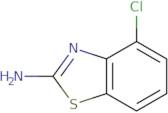2-Amino-4-chlorobenzothiazole
CAS: 19952-47-7
Rif. 3D-FA03106
| 5g | Fuori produzione | ||
| 10g | Fuori produzione | ||
| 25g | Fuori produzione | ||
| 50g | Fuori produzione | ||
| 100g | Fuori produzione |
Informazioni sul prodotto
- (4-Chlorobenzothiazol-2-yl)amine
- 2-Amino-4-chloro-1,3-benzothiazole
- 2-Benzothiazolamine, 4-chloro-
- 4-Chloro-1,3-Benzothiazol-2-Amine
- 4-Chloro-1,3-Benzothiazol-2-Ylamine
- 4-Chloro-2-benzothiazolamine
- 4-Chlorobenzo[D]Thiazol-2-Amine
- Benzothiazole, 2-amino-4-chloro-
2-Amino-4-chlorobenzothiazole (2ACBT) is a benzodiazepine receptor ligand that has been shown to bind to the benzodiazepine receptor with high affinity. 2ACBT has been used in experiments to study the role of the benzodiazepine receptor in mammalian cells, as well as its effect on other cellular processes. 2ACBT has also shown pesticidal activity against insects and fungi. 2ACBT is toxic and can cause cancer or mutations when administered at high doses. The toxicity of 2ACBT is due to its reaction with chloride ions in the body to form toxic products such as quinoline derivatives. Quinoline derivatives are produced by reactions between 2ACBT and hydrochloric acid or aromatic hydrocarbons, which are found in cigarette smoke and car exhaust fumes.





